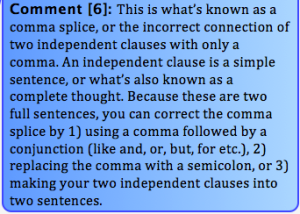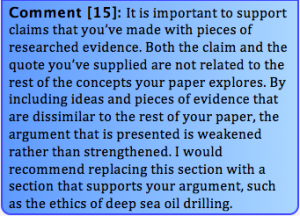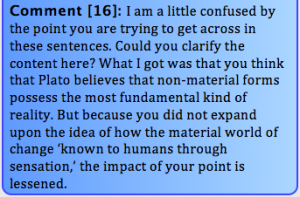As peer writing tutors at the UCWbL, we have to keep in mind all of our core practices and readings when collaboratively participating in our sessions with writers. When writing this post, I was reminded of a time, mine specifically, in which I encountered a transferable piece of advice that, despite my best attempts, has stuck. Picture grade-school me, a rosy-cheeked cherub with a spunk in his step, which at this age is still “cute” and not yet “weird,” in his Sunday best, approaching the sloping, brown sides of the Our Lady of Peace church.
Within the sacristy, a very exclusive dressing room for those conducting the mass, I approached the robes armoire, which contained my altar boy uniform. To this day, I believe I was at my most Catholic when I donned a candle wax-sodden, white robe cinched sensibly at the waist with a fraying blue rope. But it was not in my altar boy robes where I found this piece of advice, but within the armoire. Besides housing a large quantity of boring, Ordinary Time robes, this armoire also housed a placard. It read, “Say each mass as if it were your first, Say each mass as if it were your last, Say each mass as if it were your only.” In hindsight, this dictum applied more to the priest than I, a lowly altar boy with an efficient haircut. But even then I chose to deal with things in generalizations and to this, I do the same.
What this little plaque said to past me, and is still saying to present day me, is that if you are going to do something, you should always give it your best. So, from the over-incensed corridors of Our Lady of Peace Church to the generally-fine smelling UCWbL, let’s repurpose this axiom to “Work on each written feedback as if it were your first, Work on each written feedback as if it were your last, Work each feedback as if it were your only.” This blog post will review some of the most standard comments from real Written Feedbacks that need to reincorporate some of the UCWbL’s best practices. And no need to worry, the word “armoire” will be mentioned no more.
1. The “Not-Quite-There” Explanation
A Writer’s Thoughts
Ok, so I know it’s a comma splice, but what is a coordinating conjunction? I think I remember what an independent clause is, but I’m not sure. I don’t know what to do with this comment.
A Word from Our Experts
John Bean writes in “Writing Comments on Students’ Papers” that, “Part of the problem is that our comments on students’ papers are necessarily short and therefore cryptic. We know what we mean, and we know the tone we need to convey. Often, however, students are bewildered by our comments, and they sometimes read into them a tone and a meaning entirely different from our intentions” (318).
While it was appropriate for the tutor to supply the term “comma splice” to the error that was made, the tutor made a fair degree of assumption on behalf of the writer. Specifically, the mistake was that the writer would know the terms “coordinating conjunction” and “independent clause.” Like in academic writing, one should always assume that a reader is unfamiliar with discourse-specific nomenclature, or terminology specific to a field. As such, it is important that all terms are defined simply and clearly. This way, the marginal comment helps, rather than confuses the writer. Additionally, when a writer’s work can be revised in multiple ways, be sure to supply the writer with these options. This way, the writer maintains ownership of their document and can learn writing techniques that can be applied to later pieces.
The “Quite There” Explanation
Here’s an example of a comment that incorporates this advice more successfully:
2. The Sickly Sweet Comment
A Writer’s Thoughts
So the tutor thinks that I did a good thing by including this quote. This seems more like a suggestion, so I think I’ll just leave this section in.
A Word from Our Experts
In “Sugaring the Pill: Praise and Criticism in Written Feedback,” Fiona Hyland and Ken Hyland write, “Not surprisingly in such an evaluative genre, hedges were widely used to tone down criticisms and reflect a positive, sympathetic relationship with student-writers. While hedges have both an epistemic and affective function (Hyland, K., 1998), their principal purpose here was not to suggest probability, but to mitigate the interpersonal damage of critical comments” (196).
It is important for a tutor to reinforce effective writing techniques, like the inclusion of a quotation or statistic from a source, but also be clear in the purpose of their comment. In this comment, the tutor tried to get across that this quotation was unrelated to the rest of the writer’s argument and that a different quote would support the writer’s paper much better. In the tutor’s feedback above, mitigating or hedging language is used to lessen the impact of a comment that needs to be more direct in nature. While mitigating language does have its place, it might be necessary to be more directive with important writing concepts. Hyland and Hyland warn against being overly directive, but sometimes it is best to deal with problems frankly.
The “Just Sweet Enough” Comment
This comment doesn’t hedge in giving advice, and is much more direct and clear in stating what the writer might want to change:
3. The Well-Intentioned Question
A Writer’s Thoughts
What exactly was confusing? Was it the structure of my sentence or the content? This comment doesn’t really help me.
A Word from Our Experts
Nancy Sommers writes in “Responding to Student Writing,”
“In a first or second draft, we need to respond as any reader would, registering questions, reflecting befuddlement, and noting places we are puzzled about the meaning of the text. Comments should point to breaks in logic, disruptions in meaning, or missing information” (155).
Sommers also says to “dramatize the presence of the reader” (148).
This comment started out strong by calling awareness to this principle, but fell flat due to lack of detail. Could the tutor be commenting on an element that is out of place with the rest of the paper? It is hard to say. This feedback is confounded even further by the question. Question-based feedback, as Sommers writes, should help a writer understand how you interpreted their work. This perspective will help the writer reformat their paper’s content or structure in a way that is clearer. More simply, if first a question is asked and then is followed up with an interpretation, the feedback will be much more helpful.
The Well-Executed Question
This comment poses a question and tells the writer that the reader is confused, but it also clearly explains where and why the confusion happens, letting the writer know exactly where the problem lies:
Conclusion
The quality of tutor feedback increases when one keeps in mind the core readings and the writer’s interpretation of the comments we provide. And, of course, when we conduct each written feedback as if it were our first, our last, our only (very romantic), the quality of our comments are improved. Now, let’s all go on a pilgrimage to Our Lady of Peace in Darien, Illinois to thank that placard for all we’ve learned today.
Discover more from UCWbLing
Subscribe to get the latest posts sent to your email.








One reply on “Refashioning Written Feedbacks”
I LOVE the featured image for this post, Matthew! I think it’s really beautiful. Also, I thought the format of this blog was really helpful! I loved that you offered example comments, then pulled information from trusted sources to talk about them. This was really helpful for me, to see some of the readings in action!